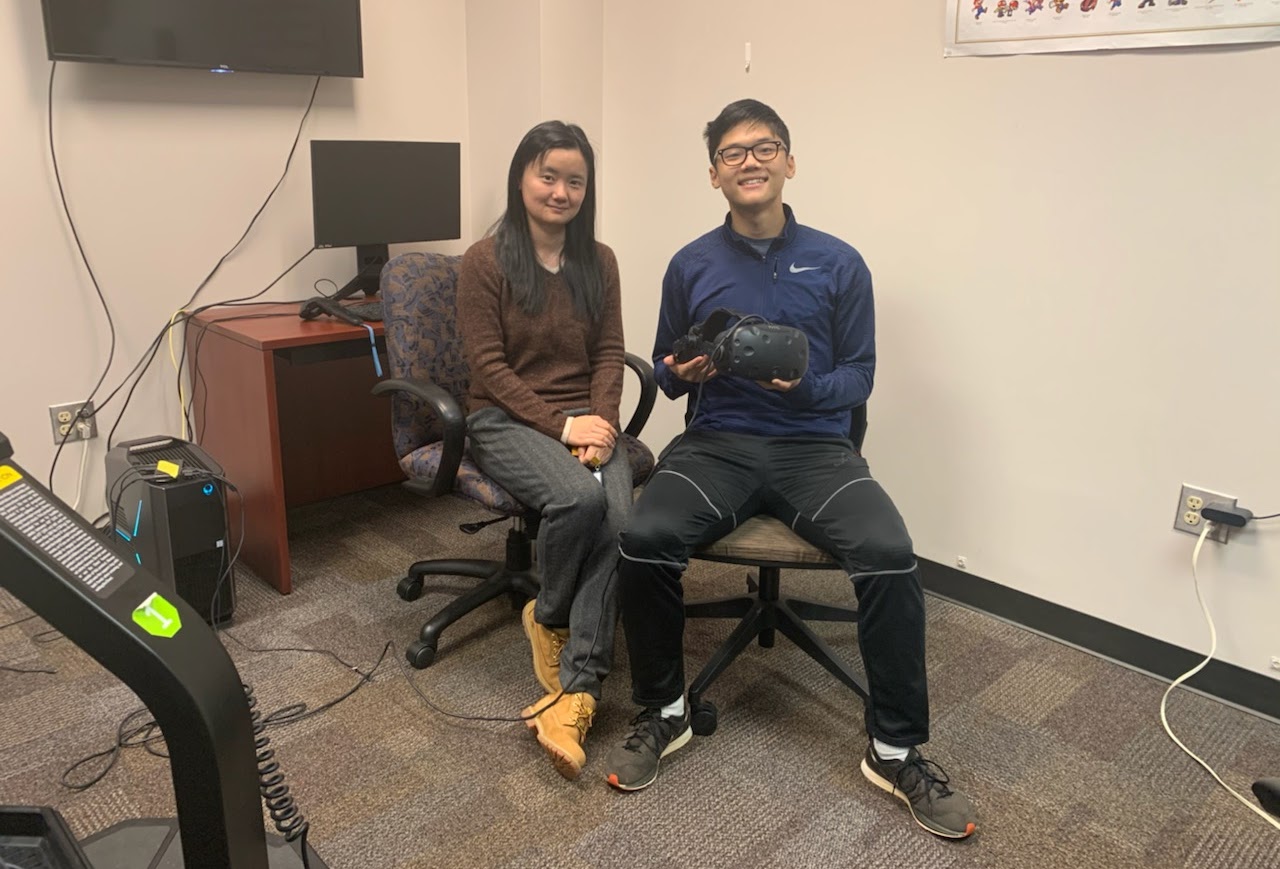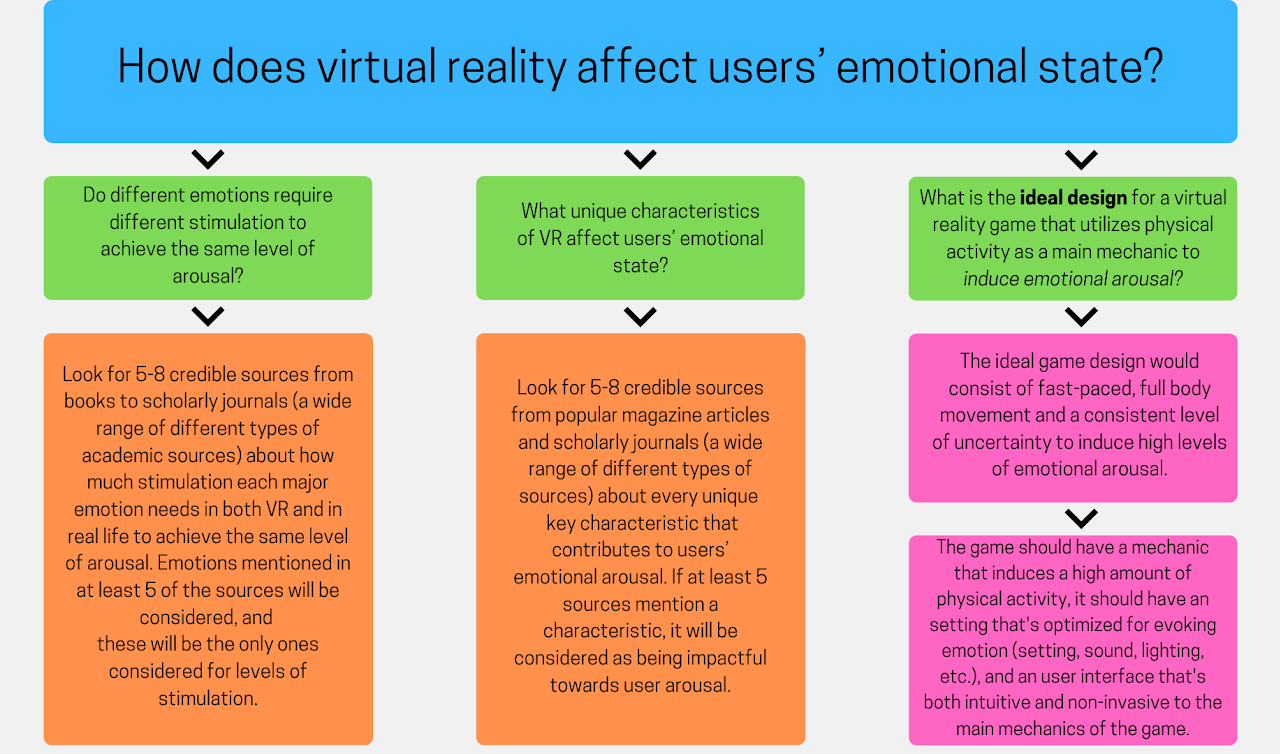Emotional VR Research Internship
The Department and My Professor

The department uniquely invests itself in game design and development, providing multiple classes and a degree for it. The department is centered around not only research into this field but also the creation of specific virtual reality solutions for clients. My professor, Dr. Joy Li, researches the emotional impact that virtual reality has on players.
What I Did

I developed and researched virtual reality solutions. Working from home 3 days a week, I came up with level designs, solved bugs and technical problems, and play-tested a lot. Every Tuesday, I went in to have a weekly checkup with Dr. Li to make sure I was making the progress I needed to be making. The goal of the game I created was to utilize the physical activity aspect of virtual reality as a main mechanic to induce emotional arousal in players.
Research
For my research project, I created a game that has a scenario where the main mechanic in all of them is moving your head to dodge them. The setting was a dark forest with crows flying toward the player’s head, which one has to be dodged physically to stay alive. Would it be possible to construct a satisfying emotional experience for this kind of scenario? The goal of development was to begin to determine the answer to this question.
Optimizing a Virtual Environment’s Characteristics for Human Emotional Psychology
Abstract
Though virtual reality can be used to evoke emotional responses (Rovira, Swapp, Spanlang, & Slater, 2009), the way in which physical activity impacts this has been relatively under-studied. Therefore, the purpose of this project was to create an effective development process for virtual reality games centered around physical activity.
Literature indicates that fear is an easy emotion to evoke (Mullen, 2013; Betka, 2013; Fritscher, 2019; Farnsworth, 2019; Neuro, 2014; Thorne, 2019), so a virtual reality game was created that included mechanics, aesthetics, and user interface (UI) in a “scary” setting that included a dark setting, crows, creepy music, and sudden changes. In order to incorporate physical activity along with the emotional response, the objective of the game is for players to dodge flying crows by moving their head, and the UI and game settings were evaluated using player feedback.
By successfully creating a virtual reality game that evokes fear and incorporates this type of physical activity, the project has implications for further, stricter testing. Specifically, additional testing by controlling for physical activity can be done to determine if physical activity is actually a significant part of virtual reality’s emotional-stimulating capabilities.

Rationale
This aim of this project is to create a game that can effectively emotionally arouse the player utilizing primarily physical activity. While immersion is a constantly desired aspect of virtual reality that is perceived to be better for emotional arousal, physiological response, a relatively under-studied aspect of VR emotional response) could impact emotional arousal as well.
As a person pursuing game development, creating a virtual reality game that can contribute to ongoing research is very exciting to me. At Kennesaw State University, this research focus could lead to the development of virtual environments that more efficiently evoke emotional arousal via better integration of physical activity. It can also lead to further, stricter research into the physical aspect of virtual reality.
Results, Conclusions & Implications
Data
Through analysis of the basic sub problems seen in the research map above, three main features were focused on: the mechanics, the aesthetics, and the user interface (UI). The final game was then evaluated to determine if it met these criteria. They were met.
Dodging the crows was a mechanic that heavily encouraged moving a lot in all three dimensions of space and rotation. As for aesthetics, the setting was also optimized for evoking emotion by having scary trees with dark colors, dark lighting, creepy music, and a sudden change of scene that added a jump-scare effect. Lastly, it had non-invasive and clear UI that the players could understand; specifically, the UI included instructions that were concise and clear, an easily discernible health bar that was not too big, and a timer that was almost always within the player’s field of vision.
All these features were tested by players multiple times, and general feedback was that the features worked as intended.
Conclusions, Implications & Future Research
The purpose of this study was to develop a virtual reality game that utilizes physical activity as a main mechanic to induce emotional arousal. Though only two iterations of the game were completed, the design can be considered a success because all the design features that were planned to be put in were implemented: the mechanics (physical activity), the aesthetics (fear-inducing scene development), and UI (instructions/player information).
What was interesting to see, though, was that while physical activity was said to contribute to emotional arousal, it seemed the combination of multiple factors is what actually caused the player to feel scared at times. Elements like music, timing, artistic choice, and lighting were crucial to the emotional arousal.
There were a few limitations to the whole process. Ideally, feedback should come from a sample larger than 10 participants (greater than 30 for statistical tests), and participant selection should be random, to increase validity and reliability. Furthermore, since each game is intrinsically unique, the concepts and conclusions of this process cannot necessarily be applied to every game that utilizes physical activity. This was not a strict research study with a high amount of control, so feedback received was strictly based on the subjective words of the participants, who each have their preferences in what they want in a game. It may have been more valid to measure physiological attributes by having heart rate and brain waves monitored or with a valid list of questions to ask them.
The implications of this study can motivate the field of VR emotional research to look into physical activity. Currently, this aspect in the field of VR is not heavily studied, but the results of this study imply that it does have an effect on emotional response in certain situations. This is a speculation based on the fact that feedback heavily favored that physical activity was important for emotional arousal.
A future experiment could control for physical activity by limiting the three dimensions of space from one scenario to the next. One scenario could be the base game in this project, while the other is the same but the player can only move through the space with a controller. Further research into more of these certain situations can help define the boundaries of how much this aspect of VR can affect emotional arousal.

